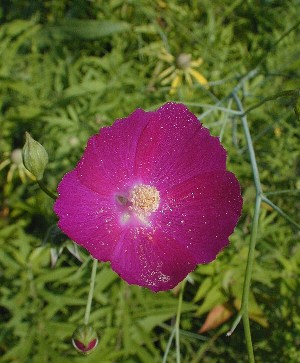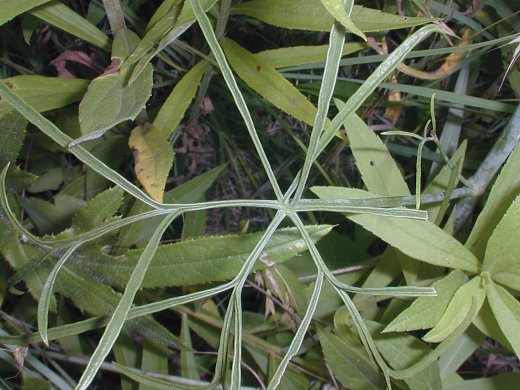 Description:
This herbaceous perennial plant is 2-4' tall, branching occasionally.
It
forms a rosette of basal leaves, which usually wither away prior to the
blooming period. These basal leaves may be triangular-cordate or
palmately lobed. The slender stems are usually glabrous and glaucous;
the lower central stem is often terete (furrowed along all sides),
while the upper stems are round in circumference. The alternate leaves
are up to 5" long and 6" across (excluding their petioles), becoming
smaller as they ascend the stems. Each of these leaves is deeply
divided into palmate lobes, which are often deeply divided into
secondary lobes. The leaves are usually glabrous and glaucous like the
stems; their petioles are up to 6" long. The upper stems terminate in
one or more flowers on long peduncles (flowering stalks). Each flower
is 1-2" across, consisting of 5 magenta petals, 5 green sepals, and a
central column of stamens and styles. The outer edge of each petal is
slightly fringed and truncate, while the sepals are triangular-ovate
with pointed tips. There are no floral bracts underneath the sepals.
The blooming period occurs during the summer and lasts about 2 months.
There is no floral scent. Each flower matures into a whorl of flattened
seeds. Each seed is rectangular, reticulated and pitted along the
sides, with little or no pubescence. The root system consists of a
woody taproot that is often swollen at the base. This plant spreads by
reseeding itself.
Description:
This herbaceous perennial plant is 2-4' tall, branching occasionally.
It
forms a rosette of basal leaves, which usually wither away prior to the
blooming period. These basal leaves may be triangular-cordate or
palmately lobed. The slender stems are usually glabrous and glaucous;
the lower central stem is often terete (furrowed along all sides),
while the upper stems are round in circumference. The alternate leaves
are up to 5" long and 6" across (excluding their petioles), becoming
smaller as they ascend the stems. Each of these leaves is deeply
divided into palmate lobes, which are often deeply divided into
secondary lobes. The leaves are usually glabrous and glaucous like the
stems; their petioles are up to 6" long. The upper stems terminate in
one or more flowers on long peduncles (flowering stalks). Each flower
is 1-2" across, consisting of 5 magenta petals, 5 green sepals, and a
central column of stamens and styles. The outer edge of each petal is
slightly fringed and truncate, while the sepals are triangular-ovate
with pointed tips. There are no floral bracts underneath the sepals.
The blooming period occurs during the summer and lasts about 2 months.
There is no floral scent. Each flower matures into a whorl of flattened
seeds. Each seed is rectangular, reticulated and pitted along the
sides, with little or no pubescence. The root system consists of a
woody taproot that is often swollen at the base. This plant spreads by
reseeding itself.
Cultivation:
The preference is full sun and mesic to dry conditions. Poor soil
containing sand, gravel, or clay is preferred, as this reduces
competition from neighboring plants. This plant has a tendency to lean
over while in bloom, especially if the soil is too moist and rich.
Range & Habitat:
The Fringed Poppy Mallow is an uncommon plant that has naturalized in
only two or three counties in Illinois (Peoria and Dupage). The
webmaster has observed this species at a prairie restoration
in Champaign County (see Distribution
Map). The Fringed Poppy Mallow is native to the southern
Great Plains, where it is more common. Habitats include upland areas of
sand prairies, gravel prairies, savannas with scant ground vegetation,
and abandoned fields. This species may appear unexpectedly in a prairie
restoration as a result of contaminated seed. In Illinois, it is not
aggressive.

Faunal
Associations:
Bees are probably the most important visitors of the flowers. Deer,
rabbits, and other mammalian herbivores eat the foliage of Poppy
Mallows readily. Rabbits often eat the lower leaves of the Fringed
Poppy Mallow (including the lower leaves of the photographed plant),
while deer occasionally chomp off the upper half of the foliage.
Photographic Location:
A restored prairie at Meadowbrook Park in Urbana, Illinois.
Comments:
Among the few Callirhoe spp. (Poppy Mallows) that
occur in Illinois, the Fringed Poppy Mallow is the tallest. It is a
lanky plant with slender stems and finger-like foliage. Some Callirhoe
spp. have floral bracts underneath the sepals of each flower;
these floral bracts have a leafy or papery-membranous appearance.
However, the Fringed Poppy Mallow lacks such bracts. It is also rather
distinctive because of the fringed outer edge of its petals, which
becomes more pronounced as the flowers mature. Other Poppy Mallows have
flowers with unfringed petals.